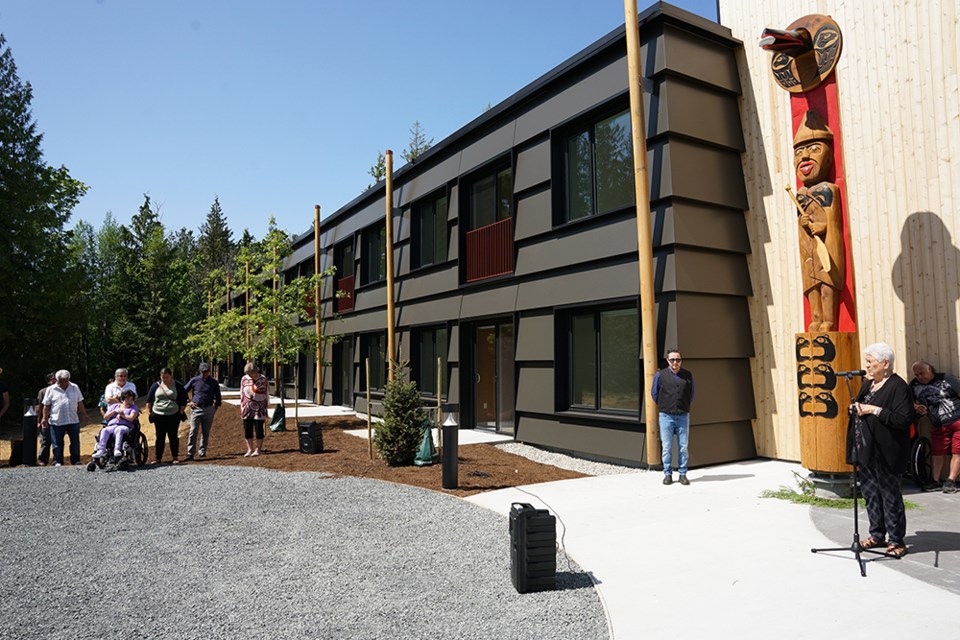Tla’amin Nation celebrated on June 1 the grand opening of ƛaχƛaχay ʔaye (Klah Klah Hay Ayeh), or Elders House, which provides 24 units of apartment-style living for elders and Tla’amin residents with accessibility challenges.
In a media release, hegus John Hackett stated: “The creation of ƛaχƛaχay ʔaye fulfills a 30-year-old vision of our elders to age-in-place, close to their grandchildren, and as active participants in community life.”
At the opening ceremony, Hackett said the elders had expressed how important it is to keep a close connection to the community and have close access to the health centre, which is adjacent to ƛaχƛaχay ʔaye.
“This is a very special day for Tla’amin,” said Hackett.
Also at the ceremony, Tla’amin elder Elsie Paul said she was thrilled to see completion of the facility.
“We’ve been waiting for this day for a long, long time,” said Paul. “I hope we are going to celebrate the day and appreciate the work done by our nation. We are short of housing now and now we have something that many of us are going to be using.”
According to the release, ƛaχƛaχay ʔaye features eight two-bedroom units, and 16 one-bedroom units, and provides safe, affordable, accessible housing for elders and people with disabilities who can still live independently. Every unit meets general accessibility standards, and a few are equipped with ceiling lifts and lowered counters for members who use wheelchairs full-time.
The purpose-built complex is located next door to Tla’amin Health Centre, enabling more efficient coordination of vital primary care, dental and home care services to elders and people with unique needs, the release stated. The complex was built less than 100 metres from Tla’amin’s Child Development Centre to foster intergenerational connection and programming.
“Elders and members with unique needs have said they want to stay in community – connected to language, culture, ceremony and one another,” stated Tla’amin health director Marlane Paul. “ƛaχƛaχay ʔaye introduces safe and accessible housing built with our members needs in mind so that they can be as independent as possible for as long as possible.”
ƛaχƛaχay ʔaye supports a core goal in the Tla’amin’s comprehensive nation plan to enhance the viability and sustainability of the Tla’amin housing stock, the release stated. The building exceeds green energy standards and includes an elevator, lobby with common spaces, amenity deck and gazebo area. A totem pole welcomes visitors at the building’s entrance.
“Tla’amin Nation and the whole of qathet are facing a dire shortage of suitable and accessible housing,” stated Losa Luaifoa, executive council member. “This project will have a generational and positive impact for our people. We thank our project partners Luma Housing, Converge Construction and Urban Arts Architecture for delivering the much-needed housing on-time and on budget.”
30 years in the making
Executive council member Dillon Johnson, at the ceremony, said the project was testament to the hard work the team at the nation was doing, and the nation’s ability to chart its own path forward as a result of having a distinct relationship with Canada and BC, through hard negotiations through the treaty process.
“When you see buildings like this it is just us trying to climb our way out of an enormous hole that the community has,” said Johnson. “I’m so proud to be here for this grand opening. Within our community it has been 30 years in the making. We continue to work on the other pieces of infrastructure and housing that we need.
“I’ve heard of this type of facility allowing for people to age in place. Our elders can also age in grace.”
The federal government provided $8.7 million through the rapid housing initiative (RHI), delivered by Canada Mortgage and Housing Corporation, the release stated, and Tla’amin contributed $2.2 million.
“This investment of $8.7 million through the rapid housing initiative means that Tla’amin Nation elders and people with disabilities now have housing in their community that is safe, affordable and culturally appropriate,” stated Ahmed Hussen, federal minister of housing and diversity and inclusion. “Every day, our government is working with Indigenous communities across BC to build housing for those who need it most—this is the national housing strategy at work.”
The RHI provides capital contributions to facilitate the rapid construction of new housing and/or acquisition of existing buildings for the purpose of rehabilitation or conversion to permanent affordable, supportive, or transitional housing, the release stated. The objective is to quickly create new permanent affordable housing units that support people who are vulnerable and prioritized under the national housing strategy.
The first tenants move in this week, according to the release.



